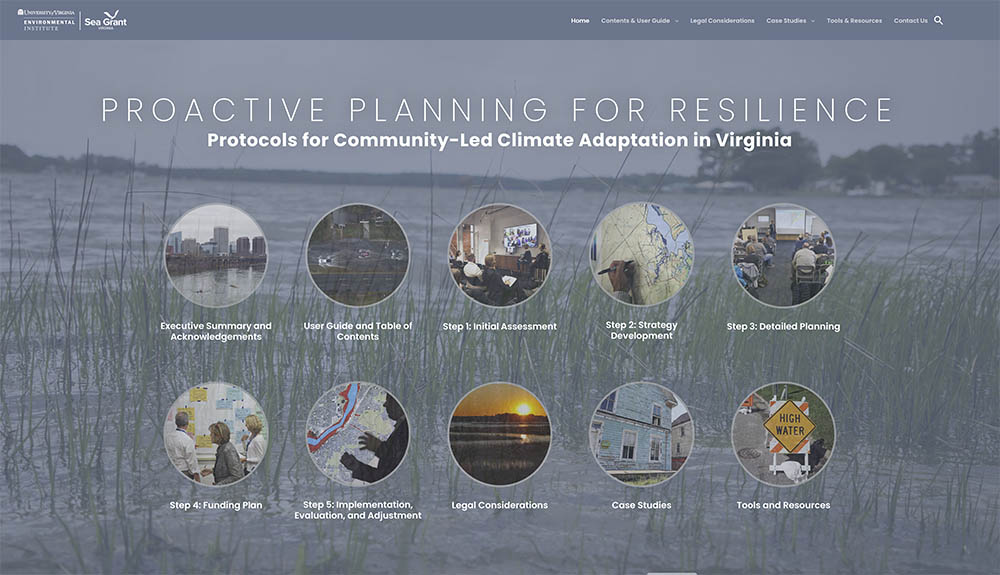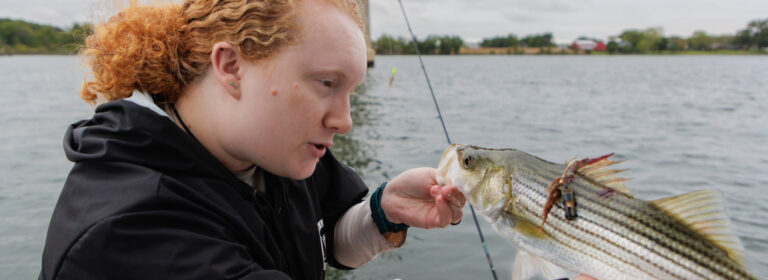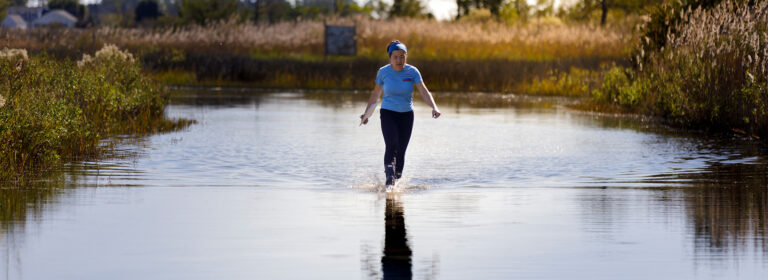UVA Environmental Institute and VASG Launch Website for Proactive Resilience Planning
The University of Virginia Environmental Institute and Virginia Sea Grant have partnered to create a new online adaptation planning guide. Proactive Planning for Resilience: Protocols for Community-led Climate Adaptation in Virginia is intended to assist Virginia’s local elected officials, government staff, and community leaders as they undertake resilience planning in anticipation of changing conditions in the Commonwealth’s coastal communities.
In the face of new realities such as rising heat and increasing flooding due to sea level rise, land subsidence, and more severe storm events, local governments in Virginia need to engage in thoughtful and pragmatic community planning. The new Proactive Planning for Resilience Guide provides some best practices for fostering planning at the local level, offering various tools and approaches to identify vulnerable areas and minimize community risk, make difficult decisions on what to save, and support moving out of harm’s way when necessary.
The Guide is a source of inspiration and information, with lessons learned from communities across the nation and world. While resources and circumstances change over time, the website will be a foundational tool for both current and future planning. It also highlights innovative ideas from other states that could be adopted in Virginia.
The Proactive Planning for Resilience Guide was developed by Elizabeth Andrews, Esq. during her term as the inaugural Environmental Sustainability and Resilience Practitioner Fellow at the University of Virginia’s Environmental Institute.
“Local governments across the Commonwealth are facing significant climate-related impacts, and it can be a daunting task to develop effective, community-led solutions,” said Andrews. “In discussions with various stakeholders, it became clear that a comprehensive guide would be helpful to assist communities as they make important adaptation decisions.”

“Local governments across the Commonwealth are facing significant climate-related impacts, and it can be a daunting task to develop effective, community-led solutions,” said Andrews.
Proactive, community-led, and inclusive adaptation planning is necessary now more than ever. Inaction is the worst choice, condemning communities to reactive, piecemeal responses rather than proactive, holistic planning for the risks.

“At UVA’s Environmental Institute, we focus on solutions to climate change,” said Karen McGlathery, Director of the Environmental Institute. “We also believe in providing communities the tools and support needed to address the climate change challenges that affect their day-to-day lives the most. This new Guide is an innovative product that integrates both of those important objectives. We are proud to support it.”
The Guide divides the adaptation planning process into 5 Steps: Initial Assessment, Strategy Development, Detailed Planning, Funding Plan, and Plan Implementation, Evaluation, and Adjustment. Each step includes specific actions and discusses some best practices, helpful tools and resources, and community engagement challenges.
“Authentic community engagement is key to successful planning efforts,” said Andrews. “A lack of community input and participation up front and throughout a planning process can result in community rejection of a local government’s plans, no matter how well-crafted and researched they are.”
Practical information in the Proactive Planning for Resilience Guide — such as the discussions of legal issues and funding programs, and the Tools Appendix with its extensive list of resilience-related resources — will provide communities with the helpful information that they need as they face these challenges. Local governments can use the Guide to help put together a suite of complementary tools such as living shorelines, public education, targeted buyout programs, regulatory setbacks, and building code requirements in floodplains, that effectively mitigate risks and encourage adaptation. The Proactive Planning for Resilience Guide is available online at adaptationguide-va.com.
About the UVA Environmental Institute
UVA’s Environmental Institute links research to action to find solutions for climate and environmental resilience challenges. The Institute fosters collaboration, providing support for new projects as well as amplifying and connecting work conducted across Grounds. EI creates opportunities for the next generation of leaders to engage with some of the toughest environmental futures challenges through interdisciplinary research and practical experiences. UVA’s Environmental Institute builds external partnerships to connect research and discovery with real world solutions.
Photos by Aileen Devlin | Virginia Sea Grant
Media contact: Jay Clark | Virginia Sea Grant
Published November 22, 2024.





